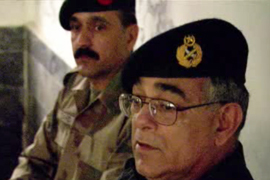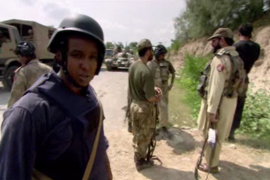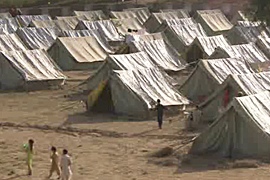
Pakistan’s tribal faultline
Rageh Omaar visits the army’s frontline in the so-called war on terror.
Watch Part 2 Part 3 Part 4
In the second part of his special series on Pakistan’s role in the so-called war on terror Rageh Omaar travelled to the country’s remote northwest late last year to witness first-hand the army’s fierce conflict with the Taliban.
The commanding Balahisar fort in Peshawar tells the story of a violent and unstable region where local rulers have, for centuries, defended their land from enemy forces.
Parts of the building are now a museum dedicated to the history of the area that is currently known as North West Frontier Province and the Federally Administered Tribal Areas.
But the fort is also the home of Pakistan’s Frontier Corps – a division established by the British in 1849 and staffed by Pakistan army officers with links to, and knowledge of, the country’s tribal areas.
Today the Frontier Corps is the vanguard of a key campaign in neighbouring Bajaur district, the front line of Pakistan’s fight in the so-called US-led war on terror.
The country’s close allies have often accused Pakistan of not doing enough to fight the Taliban and other groups but the nuclear nation is undeniably engaged in a brutal war here in the country’s tribal northwest.
Bajaur is the main transit route for Taliban fighters in and out of the Kunar province in neighbouring Afghanistan.
 |
| General Tariq is a native of the tribal areas |
The area is often referred to by the US as “enemy central” and authorities believe Ayman al Zawahiri, al-Qaeda’s number two, is among those hiding there.
“This has over the time been kind of a playground for the militants, their training ground or their space where they’ve got safe havens,” says Major General Tariq Khan, the officer leading the operations in Bajaur who has 30 years military experience and was born and raised in the tribal areas.
Khan has close relations with local tribal leaders known as Maliks, whose traditional values, he says, have become subordinate to religious leaders over the years.
“The role of the clergy was it was insignificant and what happened over the years is that the tribal Malik has been removed or has become totally irrelevant and the clergy has taken over.”
US resentment
For those fighting against the army and some local residents, Pakistan’s close alliance with the US has been the source of great anger and opposition.
In October 2006 a religious school in Bajaur was hit after an American drone flew over a compound where military officials said al-Qaeda led guerrilla training was taking place.
Local witnesses said the attack was launched by the Americans, but the Pakistani authorities took responsibility for bombing the school and killing about 80 people
The fierce reaction to the US and Pakistani governments was led by Faqir Mohammad, the local commander of the Taliban alliance, Tehreek-e-Taliban and one of the key figures now fighting the army around Bajaur.
 |
| The situation on the ground is a frequently changing one |
The Frontier Corps operation in the district began in August 2008 when a unit of 150 men was sent to establish a post in Loe Sam, only a few kilometres from the district’s main town of Khar.
Within two hours they were under attack from the Taliban and were soon surrounded prompting the army to re-launch their campaign a month later.
When I arrive in Bajaur the main offensive is getting under way and far from being a series of small raids it is apparent this is a full-scale war.
Although only a small area – 70km long and 30km wide – the army say up to 1,000 members of the Taliban are in Bajaur along with hundreds of local tribal fighters.
Guerrilla warfare
Taliban compounds and suspected hideouts are pounded on a nightly basis. The journey to Khar from Peshawar, normally three hours, is subject to an eight hour detour because of the fighting.
As we arrive near the front line a battalion led by Colonel Javad Baluch discovers a network of tunnels dug by the Taliban linking their positions.
The thick walls of the houses being used by the fighters render bullets ineffective and Javad says the army, trained for conventional warfare, now has to adjust its tactics.
“It’s classic guerrilla warfare,” he says, showing me pamphlets linked to groups such as Jihad E Afghanistan originating from Kunar province across the border.
“We have found they [the Taliban] are using black militia uniforms, so it is difficult to tell if they are police or not.”
The army suspects the Taliban will not leave the area because the houses they found are used as homes by their fighters and there are not as many booby traps in the area as suspected.
Beyond the compound is open, undulating terrain, meaning the situation on the ground is very fluid and can change at any minute.
This is emphasised as an incoming shell whizzes straight past our position.
The conditions that the army face every day demonstrate that they are fighting a classic counter-insurgency that had already claimed the lives 84 troops in three months and 1,400 since Pakistan joined the ‘war on terror’.
But civilians, many of them already impoverished, are also paying the price and 95 people have been killed in the recent fighting. A walk outside the fort into Khar is like entering a ghost town.
A township of about 11,000 people has emptied and, in total, about 300,000 people have fled Bajaur into refugee camps in Pakistan or into the cities. A further 400 families escaped to Kunar province in Afghanistan.
Government gamble
When visiting the Nowshera refugee camp that is funded by British Muslim associations I meet Noorzada, a militant teacher from Loe Sam, a town now controlled by tribal fighters.
“When the bombs started and fell on our homes [we] left our homes at about midnight and we travelled through the night over the mountains for three to four hours,” he says.
“Before the war, the Taliban were in control. They controlled everything. They had Sharia courts that dealt with all matters completely according to Sharia law.”
The grave and delicate situation in the country’s northwest has prompted Asif Ali Zardari, the Pakistani president, to seek ways of generating development and employment opportunities in the region.
The government hopes to turn the tide against the Taliban by supporting the Maliks, local tribal leaders, and taking a gamble by arming local units of tribesmen known as lashkars.
 |
| Local civilians are paying the price of the conflict |
Lashkar members say they have brought stability to the areas in which they operate but there is still a risk that as the groups become more powerful they may one day turn against the government themselves.
I return to the fort in Bajaur three weeks later and find that operations have proceeded since I was last at the front line.
I am allowed to meet prisoners who are the army say are Taliban members.
The men, who cannot be identified for security reasons, all deny they are in the Taliban.
“I came to the local bazaar and there were seven or eight Taliban there,” one man says. “They said ‘you take these machine guns and go and give then to the Taliban nearby’, I said ‘no I can’t do it’.
“A Taliban by the name of Mohammed Zada then said ‘I know you and the village that you come from and if you don’t do it we will kill you’. So I went and on the way saw soldiers, they said to put down the weapons and arrested me.”
Fierce fighting
Back on the road to Loe Sam it is possible to travel far further than before, all the way to the last compound before the town, indicating the progress General Tariq and his men have made.
It has come at a price with ferocious counter-offensives by the Taliban killing seven men and wounding 27, including a colonel who had to have his foot amputated.
At the sound of shooting we are told to leave and that we should not have been in such an advanced position as the line is still active.
As I leave, the army is putting everything into the fight in the final push to rid Loe Sam of the militants. It has taken them three months to seize back Bajaur.
The Taliban and al-Qaeda have been forced away from the Afghan border but they are now closer to the major cities.
Authorities say the fighting here has shown the Taliban and other groups that they cannot set themselves up as the alternative rulers in the tribal areas.
“I think we have a consensus at the national level and that is a corner we have turned and the people and the tribes have decided to stand up and I think they have the confidence,” General Tariq says.
But for many Pakistanis this reality is obscured by deep resentment of American interference in Pakistan’s affairs and as long as the leadership of al-Qaeda survives with Taliban support the fierce conflict will continue.
